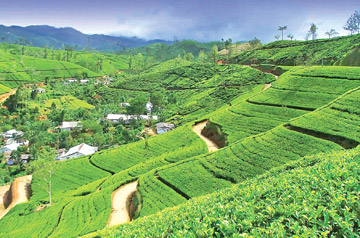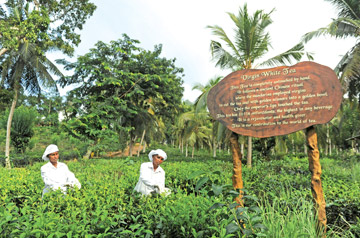|
New technology, new types of tea essential :
Lanka's tea industry would continue to thrive
By P. Krishnaswamy
Sri Lanka's tea industry with the world's longest history of export
production is still sustainable and would continue to contribute
substantially to the national economy in spite of the many challenges
faced in recent years, a cross-section of those engaged in the
production and export of the industry told the Sunday Observer.
 They were optimistic that the industry, which stood the test of time
for over 140 years, would thrive, but policy makers should contemplate
on future programs to address the high cost of production, low yield per
acre, the changing weather patterns that impact on the industry and the
acute labour shortage. A different model to tie-up production with
labour costs, as practised in other tea-producing countries, should be
given serious thought, they said. They were optimistic that the industry, which stood the test of time
for over 140 years, would thrive, but policy makers should contemplate
on future programs to address the high cost of production, low yield per
acre, the changing weather patterns that impact on the industry and the
acute labour shortage. A different model to tie-up production with
labour costs, as practised in other tea-producing countries, should be
given serious thought, they said.
An analysis of climate data in recent years clearly revealed a
climate change pattern as monthly rainfall was erratic in all tea
growing regions, a research professional of the Tea Research Institute
(TRI) said. Monthly rainfall during the North-East monsoon had dropped
considerably in all regions. The number of dry days had increased
significantly, contributing to low crop yields, he said. All in all, it
could be summarised that a noticeable change in weather parameters
occurred in some years in the recent past, contributing to significant
crop losses, he said.
The tea industry crisis started in 2008 and continued through the
first quarter of 2009. Tea auction sales and prices started improving
during the second quarter of 2009 due to government policy
interventions, financial assistance extended to the small holder sector
through the fertiliser subsidy and low interest bank loans to the
Regional Plantation Companies (RPC) and private tea factory owners.
Jayantha Keragala, Managing Director, Ceylon Tea Marketing (Pvt) Ltd,
a leading tea exporting company, said that global warming and the
changing weather patterns have impacted on the industry in recent years.
Finding new cultivars to withstand the changing weather patterns is a
primary need. Finding adequate funding to the TRI and strengthening it
will go a long way in making the tea industry sustainable, he said.
Many scientists who played a big role in identifying suitable
cultivars have resigned and gone for overseas jobs because the
remuneration packages which they received were comparatively low.
Tea smallholders should be given incentives and assistance for
following a proper agricultural management system for conserving soil
conditions, as presently done by the corporate sector- the RPC -
considering the fact that they produce almost 70 percent of export
quality tea.
Replanting subsidy
He welcomed the Government's decision announced under the last budget
to increase the replanting subsidy from Rs.300,000 to Rs.350,000 per
hectare from 2013 to encourage replanting among smallholders. But the
RPCs were incurring considerably more expenditure on replanting, he
pointed out.
Tea production in Kenya is 3,000 - 4,500 Kg per acre, almost double
that of our production. The best method for boosting production is to
tie up production to labour costs or placing tea land in charge of the
labourers, as practised in Kenya, so that they will have a commitment
towards higher production, he said. The labour shortage could also be
overcome if this is done because it would be an inducement to the
younger generation who now wants to distance themselves from plantation
jobs.
 Most Sri Lankan tea exporters now focus on adding more value to
exports rather than exporting raw tea, other sources said. The health
benefits of tea should be the main focus of propaganda for boosting tea
exports, the sources said. Most Sri Lankan tea exporters now focus on adding more value to
exports rather than exporting raw tea, other sources said. The health
benefits of tea should be the main focus of propaganda for boosting tea
exports, the sources said.
The name 'Ceylon Tea' or 'Sri Lankan Tea' is still regarded as a sign
of quality throughout the world. The Manganese and Potassium in a cup of
tea help maintain the body's fluid balance. Besides these ingredients,
tea contains a unique amino acid, theanine, which has a relaxing effect
on humans and also assists the natural immune response to infection. The
modest amount of caffeine in tea also acts as a mild mood enhancer.
Perhaps, the most significant health-promoting properties of tea lie
in the antioxidants or 'flavonoids' it contains. Antioxidants are
compounds that help remove harmful toxins from the bloodstream, and tea
contains uniquely high concentrations of them. Research has shown that
consuming such antioxidants can lower the risk of heart disease, strokes
and cancer.
There are also indications that antioxidants in tea may help protect
against Alzheimer's disease and age-related memory impairment. Black and
green tea contain higher levels of antioxidants than common fruits or
vegetables. Even if we disregard extravagant, scientifically unsupported
claims, the established health benefits of tea are numerous. Many of
these benefits are preventive, suggesting that a few cups of tea a day
can help stave off heart disease, diabetes, hypertension and many forms
of cancer, they said.
Increasing costs
The cost of tea production is increasing while the market demands
lower prices. Where modern technology related to tea production is
concerned, the cost of production is very high in comparison with other
agricultural products. Ceylon Tea is consumed by many tea lovers all
over the world, especially in Europe, Asia and the Middle East. However,
for the product to remain competitive among the global tea exporters, we
must focus on new strategies. In addition to the quality standards
maintained in the conventional tea industry, the percentage of value
addition to the product should be gradually increased, to give a
different product to the market. It helps to create high competition
among core competitors. Value addition should be executed in a manner to
fulfil strong consumer requirements and environmental protection. Using
an eco-green system in production to combat global warming, maintaining
biodiversity in plantations, offering social responsibility to the
workers, convenience and sensory satisfaction are some of them, they
said.
Value addition can be done initially by primary production
procedures. Organic and bio-dynamic production methods add value to the
tea, as a bulk production. The best value addition that could be done is
the conversion of tea production to organic tea which is about 100
percent against 2.5 percent for conventional tea.
Demand for organic products is rapidly growing mainly due to health
concerns of consumers in the developed importing countries. The
important thing is changing market patterns and strategies towards other
sectors such as Europe, North America, Canada and Japan which will
result in minimising the high risk of market domination by CIS and the
Middle East and enjoying higher revenue from tea exports to secure
Western markets mainly in value added tea. Tea in bags in many forms has
become popular because of convenience and it can be considered as an
effective form of value addition, the sources pointed out.
A strong foundation should be laid by the Sri Lanka Tea Board to
support and guide local producers to reach the needy quality
requirements, by introducing Ceylon quality certificate for the
long-term sustainability of Sri Lanka's tea industry. Installing new
technology is now more essential than ever before, to introduce new
types of tea for the special niche markets, they said. |



